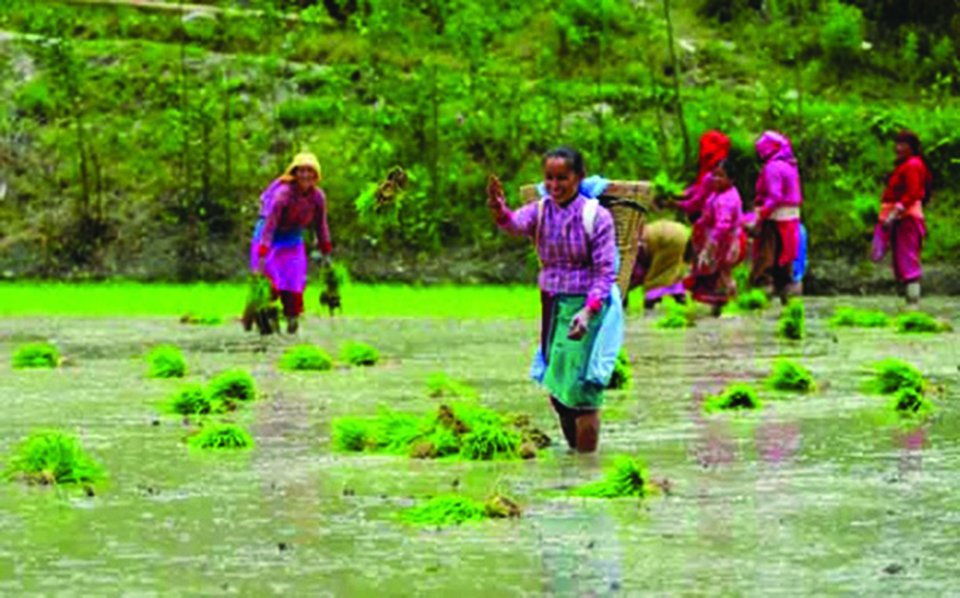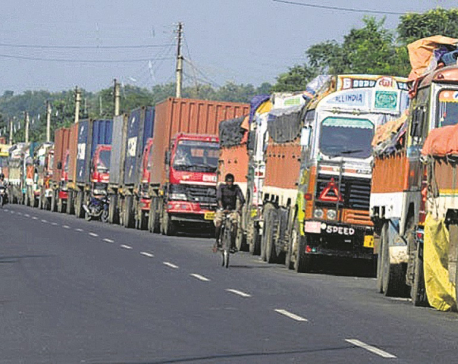
OR
How do we achieve sustainable agriculture growth?
Published On: September 23, 2019 12:24 AM NPT By: Bhairab Raj Kaini

Nepal is a food deficit country, importing both cereals and high-value agriculture commodities due mainly to slow agricultural growth rates. The government’s commitment to check the country’s ever widening trade deficit by boosting farm production is difficult to achieve unless implementation is improved.
The 10 year average of agriculture growth from 2061-62 to 2071-72 BS was 3.2 percent. The growth rates thereafter are also showing the same patterns except in 2074-75 BS. So it is not easy to meet the 15th plan target of 5.6 percent. The growth rates are not only low, but they are also erratic.
This type of growth pattern is a result of dependency of agriculture on monsoon rain, use of traditional practices in production and broken value chain. Farming in Nepal is less science-based and more traditional. In most parts of the country, use of traditional practices is still common and the adaption of science-based technology by the farmers is rare.
Even after implementation of the Prime Minister Agriculture Modernization Project, agriculture is suffering from under-investment, limited technology and scant inputs. The average farm size has shrunk from 1.1 hectares in 1995 to 0.5 hectares as of now, often too small to generate income above the poverty line.
Challenges and solutions
Climate change is bringing higher average temperatures, changes in rainfall patterns, and more frequent extreme events, multiplying the threats to sustainable agriculture growth. In fact, agriculture in Nepal is facing multiple challenges at present and these challenges will be more serious over the coming decades. Population pressures and low incomes are forcing poor farmers to cultivate land that is not suitable for agriculture. Today’s basic needs of survival are forcing them to sacrifice tomorrow’s ecological sustainability. Furthermore, some good agriculture practices such as crop diversification, crop rotation and mulching, organic recycling and soil-water conservation are not followed properly by the farmers due to their ignorance.
Addressing these challenges requires coordinated responses from both the public and private sectors. There is a need of paradigm shift to the approach of agriculture production which involves combining traditional wisdom and experiences with modern technology.
In order to make the agriculture growth sustainably progressive, the production approach should be acceptable, adoptable, profitable and environment-friendly. It should give less emphasis on non-renewable and external resources. Instead, greater reliance should be on renewable resources, improved crop varieties of open pollinated types, irrigation water availability and management, soil management, and crop diversification.
There is little room for expansion of arable land. Raising yields on existing farmland is the only way forward for sustainable agricultural growth. However, the large yield gap for major crops in Nepal indicates that we could have significant yield increases with the use of adequate inputs and appropriate technologies in production. There have been significant improvements in agricultural infrastructures in the recent years. Recent spread of mobile phones has opened up opportunities for effective and speedy market information system.
In Nepal, crop production is still constrained by too little application of manures and fertilizers. Fertile soils with good physical properties to support root growth are essential for sustainable agriculture. Continuous cropping and inadequate replacement of nutrients removed in harvested materials or lost through erosion, leaching or gaseous emissions deplete fertility and cause soil organic matter levels to decline, often to half or less of original levels.
Erosion is severe on steep slopes where natural windbreaks have been cleared, and vegetative cover is absent during the rainy season. Under such conditions, judicious application of manures and fertilizers is essential.
Sustainable agricultural production also requires efficient irrigation. Many countries will soon fail to have adequate water to irrigate their crops but Nepal will not have this problem at least for the coming 50 years or more as we have plenty of water resources. Nepal’s problem is how to tap the wasted water for irrigation. Furthermore, technologies such as drip and pivot irrigation can improve water-use efficiency. These irrigation technologies have already been introduced in Nepal in small scale. It will be wise to scale them up.
So far, only 54 percent of the total cultivated land is irrigated seasonally. The percentage of all-the-year round irrigated area is below 25 percent. There are several occasions that crop production increases when monsoon rain is adequate and well distributed. In fact, Nepali agriculture still remains heavily dependent on the rainfall. So the year with adequate and timely rainfall is expected to increase rice production.
Last year, rice production was increased due to adequate and timely rainfall. But in order to make the production system reliable, the future programs of crop production, especially rice production should concentrate on making availability of irrigation water as needed and its efficient use. Improvements in the management of weeds, crop diseases and pests, and herbivores are also equally important to significantly increase crops yields.
Other technologies with the highest percentage of potential impact for agriculture include no-till farming, nitrogen-use efficiency, drought-tolerant crops, and integrated soil management. Nitrogen-use efficiency could increase rice crop yields by 22 percent, but irrigation increases the yields by another 21 percent.
Seed quality is a crucial determining factor of yield and quality of crop production. Development of hybrid seed varieties that adapt to unfavorable climatic conditions and are resistant to a range of pests and diseases are at the forefront of the seed industry in improving crop yield. Hence, use of high-yielding varieties of rice, corn, and vegetables is in increasing trend for enhancing crop yield.
If the government really wants to achieve the targets of doubling agricultural produce through sustainable growth, ministries of agriculture, land management and irrigation should first be integrated without any delay. The existing knowledge support system should be strengthened. At the same time, restructuring present institutions under the ministry with improved governance in production and marketing should also get priority. The present day agriculture is demanding innovative minds. But this is lacking.
Thus orientation of existing officials needs a paradigm shift. Youth should be attracted in commercial agriculture. The agriculture sector also requires adequate investment from public and private sectors. Though public budget allocation in agriculture sector in the recent years has been increased significantly, it is more focused on recurrent expenditure and investment in capital formation is negligible. Unless investment is increased in capital formation, agriculture growth cannot be sustainable.
bhairabr@gmail.com
You May Like This

Trade deficit declines but at a slower pace
KATHMANDU, March 24: Nepal's trade deficit in the first eight months of the current fiscal year reached Rs 849.33 billion,... Read More...

Agriculture Knowledge Centre established
SAPTARI, Oct. 4: An Agriculture Knowledge Centre has been established in Rajbiraj district by the Ministry of Land Management, Agriculture... Read More...

All activities of Agriculture and Forestry University, Rampur, halted
RATNANAGAR (Chitwan), August 7: All activities of Agriculture and Forestry University, Rampur, have been halted for the past one week... Read More...




Just In
- Govt receives 1,658 proposals for startup loans; Minimum of 50 points required for eligibility
- Unified Socialist leader Sodari appointed Sudurpaschim CM
- One Nepali dies in UAE flood
- Madhesh Province CM Yadav expands cabinet
- 12-hour OPD service at Damauli Hospital from Thursday
- Lawmaker Dr Sharma provides Rs 2 million to children's hospital
- BFIs' lending to private sector increases by only 4.3 percent to Rs 5.087 trillion in first eight months of current FY
- NEPSE nosedives 19.56 points; daily turnover falls to Rs 2.09 billion
















Leave A Comment